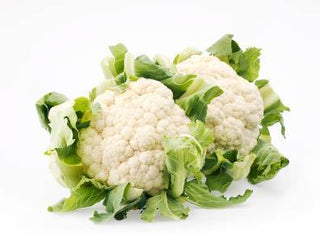(Brassica oleracea)
Cauliflower is one of several vegetables in the family Brassicaceae including cabbage, Brussels sprouts, kale, broccoli and collard greens.
Descended from wild cabbage, cauliflowers once closely resembled kale or collards. These days, cauliflowers form a compacted head of undeveloped white flower buds called the “curd”. A tight encasing of heavy green leaves surrounds these buds. These leaves protect the cauliflower from the sun and prevent the development of chlorophyll; no chlorophyll gives this vegetable its creamy coloring.
Thought to have originated Asian Minor, records of cauliflowers in Cyprus date back to as early as the 6th century B.C.E. A thousand years later, cauliflowers had gained popularity in Turkey and Syria. From there, the cauliflower was introduced to Spain and Italy, and then on to France and the British Isles. Cauliflower made its America debut sometime in the early 17th century.
This crisp, mild vegetable is one temperamental member of the garden patch! Very difficult to cultivate, cauliflowers grow best in relatively cool, moist climates. Extremely sensitive to unfavorable conditions, cauliflowers cannot withstand any real variance in temperature. Unlike their hearty relative kale, cauliflowers will not survive a frost. Despite this vegetable’s picky disposition, California manages to produce an ample cauliflower crop year round. Arizona produces a crop from December through April.
There are three primary types of cauliflower: Early, Autumn and Overwintering, named in reference to their harvest season. Several popular traditional commercial varieties include the Snow Crown, Romanesco, and Fremont.
In recent years, you may have noticed that cauliflower is no longer just white but comes in shades of green, orange and purple. The green curds are from a cross between cauliflower and broccoli and is sometimes referred to as broccoflower. The flowering heads are less dense and the flavor is milder.
A mutant cauliflower in Canada produced a line of bright orange cauliflowers, containing 25 times the amount of Vitamin A as their white counterparts. The purple variety, called Purple Cape, are high in anthocyanins – the same potent antioxidant found in many deep blue/red fruits and vegetables including red cabbage, red grapes and berries.
Nutrition
With just 25 calories and a hearty 3 grams of fiber per cup, cauliflower is an excellent choice for anyone watching their waistline. Along with its low sugar content, cauliflower has a glycemic index of just 15. With an unusually high protein content for a vegetable (19% of calories are from protein), cauliflower is both filling and nutritious.
Cauliflower is an excellent source of vitamin C, with 46 mg per serving or 77% of daily values. It is also a good source of vitamin K, providing 20% of daily values. This vegetable is also a good source of vitamin B6, folate and potassium.
Health Benefits
Cauliflower, along with other cruciferous vegetables, contains glucosinolates and thiocyanates, phytonutrients known for their anti-cancer activities. One of these glucosinolates, sulforaphane, is an antioxidant released when cauliflower is chopped or chewed. Sulforaphane triggers the liver to produce detoxifying enzymes that may reduce the impact of cancer causing free-radicals and carcinogens.
Along with other brassica vegetables, cauliflower is a source of indole-3-carbinol. This phytonutrient boosts DNA repair in cells and may stimulate the enzymes that block the growth of certain cancer cells. Preliminary studies may indicate that indole-3-carbinol affects the metabolism of estrogen in the body and can slow or prevent tumor growth in the case of breast, ovarian and prostate cancer.
Selection and Storage
When selecting your cauliflower make sure to choose a head that is firm, compact and creamy white. Avoid any signs of yellowing, as this indicates subsiding freshness. Avoid speckling or brown patches on the leaves or cauliflower head as this can mean insects or mold. To ensure you get the best cauliflower in the bunch, don’t forget to check the greens that wrap the underside of the cauliflower. These leaves should be fresh looking without any signs of withering.
To maintain optimal freshness, store cauliflower stem side up in the crisper drawer of the refrigerator. Storing the cauliflower with the head facing down will prevent water droplets from gathering and forming mold on the curd. Stored in an open or perforated plastic bag cauliflower will remain fresh for approximately 5 -7 days. Precut florets, while more convenient, do not keep as well and should be consumed within a day of purchase.
Like other cruciferous vegetables, cauliflower contains sulfur and will omit unpleasant odors if overcooked. Rapid cooking via microwave or steaming preserves texture, taste and the majority of cauliflower’s nutrients. Cauliflower should never be boiled, just five minutes compromises 30% of cauliflower’s anti-cancer compounds. When cooking, avoid using an iron or aluminum pot; contact with these metals can cause the cauliflower to turn yellow, brown or blue-green. To preserve a crisp white while cooking, drop a bit of milk or lemon juice in cookware.
Recipes
Deliciously crunchy and delightfully healthy, cauliflower is a perfect snack or side dish served raw, pickled or cooked.
Dip raw cauliflower heads into hummus. Or, serve picked cauliflower with other crudities.
Virtually identical in texture, mashed cauliflower is a healthy alternative to mashed potatoes.
For an entire collection of healthy cauliflower recipes, check out the site EatingWell. Doesn’t Balsamic & Parmesan Roasted Cauliflower sound phenomenal?
Fun Facts
Broccoli and cauliflower are the only vegetables that are flowers.
